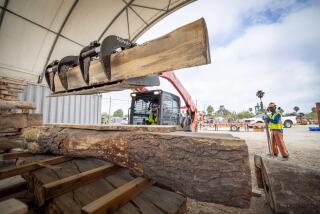Competitors Leave National Lumber in Need of Repair : Retailing: The do-it-yourself chain has fallen badly behind the larger, national outlets, and seems to be all thumbs so far in its attempts to recover.
- Share via
FOUNTAIN VALLEY — When Sol Jaffee opened his used lumber store in Bellflower in 1942, Southern California was still a sleepy agricultural region.
But World War II unleashed a powerful economic expansion that changed the region’s complexion forever, and National Lumber and Supply was in a position to prosper. As an unprecedented postwar building boom turned orange groves into housing tracts, National Lumber thrived and gradually evolved into a chain of 21 do-it-yourself hardware stores.
Since the mid-1980s, however, Fountain Valley-based National Lumber has proven less adept at reacting to changes in its market and has stumbled badly. Newcomers to the area, like Home Depot, Builders Square and HomeClub have changed the rules and National Lumber has had operating losses for the last five years. In fiscal 1989, National Lumber watched its annual revenue fall for the first time in the company’s history.
Attempts in the last year to restore profitability have so far met with little success, making it unclear how the chain will be able to recover as it moves into the new decade. Industry observers and analysts suggest that National Lumber must make bold changes in its marketing and management if it is to regain its market.
“They didn’t pay attention to the changes. But that’s easy to do if everything’s gone well for decades,” said Ward Lindenmayer, who once followed the company for the brokerage firm Sutro & Co. in San Francisco. Like most other investment analysts, Lindenmayer lost interest in the company as its performance deteriorated.
The company’s condition has deteriorated since scoring record earnings of $2.1 million in fiscal 1983. In fiscal 1989, which ended Jan. 31, 1989, National Lumber lost $4.6 million. For the first nine months of fiscal 1990, the loss was $4.4 million.
The decline has decimated the value of the company’s stock. Offered to the public at $10 per share in 1983, shares have been worth as little as 87 1/2 cents recently, and closed Friday at $1.25 in over-the-counter trading.
National Lumber was once a pioneer in the industry, being among the first retailers to develop into a full-service home improvement center and to expand beyond a single store.
Melvin Jaffee, son of Sol Jaffee and president of National Lumber since 1965, is widely credited with spearheading the company’s expansion. National Lumber opened its second store in 1965, and added two more by the end of the decade including the first in Orange County. The chain added five stores in the 1970s and 13 more in the 1980s for a total of 22, all in Southern California. One store has since closed.
The company made its first public offering in 1983 primarily to raise money for expansion, according to V.J. Carnevale, the company’s chief financial officer. The offering raised $10 million.
But as National Lumber was raising money to build more mid-size stores, the large national chains were planning their moves into Southern California.
These chains recognized the rapid growth in the do-it-yourself and building industries, and opened 100,000-square-feet warehouses, crowding out the neighborhood hardware stores, lumber yards and regional home-decorating centers that had dominated the market for years. Industry leader Home Depot, based in Atlanta, opened its first California store in Orange County in 1985, and now has 19 stores in Southern California.
The Southern California home-improvement retail market is estimated by industry executives to be worth as much as $5 billion a year. Nationally, home improvement industry sales were $107 billion in 1988, according to National Home Center News.
The large retailers have located nearly side-by-side with smaller companies like National Lumber, whose stores average 60,000 square feet. The national chains can overpower their smaller rivals when it comes to variety, price and service.
The results show in the stores’ performance. For example, Home Depot, which has 119 stores nationally, had sales of $289,000 per square foot at its stores in 1988, an increase of 7.3% over a year earlier. For National Lumber, sales per square foot were $175,000 in fiscal 1989, a drop of 9%, and below the company’s 1981 level.
The larger stores have also been more successful at managing inventory and costs. National Lumber finished installing a computerized inventory system last year, several years behind most retail chains, and four years after the installation began.
When the large chains expanded most rapidly in the mid-1980s, National Lumber tried to remain the low-price leader, but at the expense of profits. By fiscal 1989, gross margins improved, but the company was unable to bring in customers, and sales slipped from $159.3 million for fiscal 1988 to $152.4 million for fiscal 1989.
In the company’s annual report for fiscal 1989, Melvin Jaffee said National Lumber was making a number of major changes to boost sales, including a restructuring of store operations, redesign of advertising, in-store merchandising improvements and employee incentives. But stores have continued to do poorly, and for the first nine months of fiscal 1990, revenue lagged by 8% over the year-earlier period, at $107.8 million.
Some industry analysts attribute the continuing problems in large part to the leadership style of 56-year-old Jaffee, described by one analyst as being “autocratical.”
Industry observers and a former National Lumber employee said the firm is run in a highly centralized style not uncommon to family-operated businesses.
Melvin Jaffee, who earned $341,000 for fiscal 1989, owns 50% of the company’s stock, and another 13% is held by a brother, Eugene Jaffee, who is not involved in the operation of the company. Sol Jaffee, now 83, is company chairman, but leaves company decision-making to his son.
Jaffee declined to be interviewed for this article. He said he plans to make a major announcement regarding the company’s operations on Friday.
Jaffee’s senior management team consists of Carnevale, 72, who joined as an employee in 1983, and had been the company’s banker since 1962, and executive vice president Jordan G. Silverberg, 63, who has been with the company since 1977. Craig R. Schumacher, 41, who was in charge of store operations, also worked closely with Jaffee until Schumacher resigned a year ago.
“Other retailers in the industry rely on young managers for a great deal of input. At National Lumber, Mel Jaffee is clearly in charge,” said Gary Ruderman, who writes on the company for National Home Center News, a trade journal based in New York.
“This is a company in which store managers don’t develop budgets or order merchandise without most decisions being made at the top,” said a former National Lumber assistant store manager, who now works for another home improvement chain.
National Lumber’s longtime advertising campaign even bears Jaffee’s stamp. Cartoon mascots Cheap Chicken and Shorty were created by Jaffee in the 1960s. The screechy-voiced characters, who use wit to pitch the stores’ products, have given the company name identity with consumers. But the characters are criticized by executives in the ad industry as being not only amateurish and antiquated, but also ineffective.
In November, National Lumber dismissed Stiller Advertising in Costa Mesa, the company’s ad agency of record for the last four years. The company has not hired a new agency but has retained the mascots.
Also during the fall, National Lumber dismissed its outside investor relations firm Clive Hoffman Associates Inc. in Los Angeles and the company ended a longtime credit relationship with Security Pacific National Bank in Los Angeles.
In September, National Lumber signed an agreement for a $13-million line of credit with Fidelcor, a Pennsylvania-based company. The new line of credit, which National Lumber said carries a higher interest rate than the agreement with Security Pacific, is being used to open new stores, remodel existing ones and pay off $7 million in debt owed to Security Pacific.
Lindenmayer and other industry observers are skeptical that Jaffee will be willing to make enough changes, or give up some of his authority, to turn the company around.
Other retailers have adapted to the competition from the national chains by closing stores, changing marketing strategies, or even selling their businesses.
Builders Emporium, a chain of mid-size stores, tried unsuccessfully to compete with the mega-stores on price. The result was sharply reduced profits in 1987 and 1988. But after a leveraged buyout the company undertook an extensive reorganization and in 1989 began to see improved sales.
“We’ve had to make major changes and scrap a lot of old ideas,” said John Kearney, executive vice president of the Irvine-based company, which operates most of its more than 100 stores in Southern California.
“We stepped back and decided not to compete on lumber and big building products. Instead, we’ll be dominant in hardware, plumbing, home decor and the nursery.”
National Lumber must make similar significant marketing and merchandising changes if it hopes to revive its sales and earnings, said Wayne Hood, an analyst with New York-based Prudential-Bache research.
In addition to focusing on high-margin items, National Lumber might seek to expand its share of specialty markets, such as building contractors or upscale buyers.
Small retail chains in other parts of the country have been successful at selling to building contractors by opening early in the morning, and having separate entrances, and sales people for them, said Ann Marie Moriarty, an editor of Remodeling, a Washington-based magazine for contractors.
In a shift from its longtime strategy of low prices, National Lumber in November opened a store in Oceanside that attempts to reach more upscale buyers. The store, which features a wide assortment of custom products, is to include a professional kitchen sales staff and in-house installation contractors.
While the upscale approach may become a prototype for new or existing stores, it remains to be seen whether such changes are enough to restore National Lumber’s health in the face of competition that becomes more severe with every new home improvement warehouse.
Hard Times At National Lumber National Lumber has lost money for six consecutive quarters. Competition from mega-stores like Home Depot has forced the company to consider newstrategies as it enters the 1990s. Profile Headquarters: Fountain Valley Total stores: 21 Employees: 1,170 Founded: 1942 Top Officers Sol Jaffee, 83, Founder, Chairman Melvin Jaffee, 56, President, CEO Jordan Silverberg, 63, Executive V.P. Vincenzo Carnevale, 72, Chief Financial Officer, V.P. Board of Directors Sol Jaffee, Founder, Chairman Melvin Jaffee, President, CEO Jordan Silverberg, Executive V.P. Lawrence Gordon, Attorney Victor Carter, Retired, former owner of Builders Emporium Haim Ben-shahar, Economics professor Marvin Weiss, President, Eldorado Carpet Mill Closing Stock Prices Fiscal years ending Jan. 31, high and low closing prices in dollars: 1988 High: $7.75 Low: $2.75 1989 High: $3.38 Low: $2.00 Last 52 weeks High: $3.13 Low: $o.88 Revenue and Earnings/Loss, By Fiscal Year In millions of dollars: Revenue, by fiscal year 1984: $127.9 1986*$136.4 1987: $151.3 1988: $159.3 1989: $152.4 Earnings, Loss, by fiscal year 1984:$1.3 1986*: -$0.2 1987: -$2.4 1988: $0.2 1989: -$4.6 * In 1985, National Lumber converted from a calender year to a fiscal year. Fiscal 1986 results are for the 1 3-month period ended Jan. 31, 1986. National Lumber Revenue and Earnings/ Loss by Quarter In millions of dollars Revenue by Quarter 1989 1st: $38.1 2nd: $41.6 3rd: $37.1 4th: $35.3 1990 1st: $34.3 2nd: $39.6 3rd: $33.9 Earnings/ Loss, by Quarter 1989 1st: $0.1 2nd: $-$1.0 3rd: $-$1.7 4th: $-$2.0 1990 1st: -$1.4 2nd: -$o.6 3rd: -$2.4 Source: Company’s fiscal 1989 Statement 10-K, annual report, other sources
More to Read
Inside the business of entertainment
The Wide Shot brings you news, analysis and insights on everything from streaming wars to production — and what it all means for the future.
You may occasionally receive promotional content from the Los Angeles Times.










